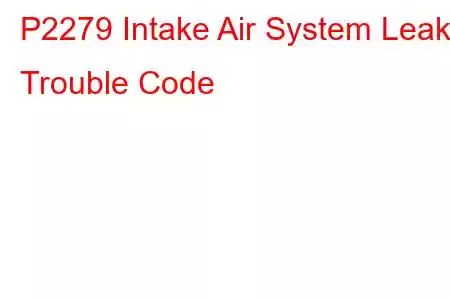P2279 Intake Air System Leak
OBD-II Trouble Code Technical Description
Intake Air System Leak
What does that mean?
This is a generic diagnostic powertrain trouble code, which means it covers all makes/models, 1996-newer. However, specific troubleshooting steps will vary depending on the vehicle.
Trouble code P2279 indicates that an air leak has occurred on the "metered" side of the intake manifold. There is more air entering the intake manifold than the mass airflow or MAP (manifold absolute pressure) sensor would suggest.
The engine uses a mass airflow sensor or MAP sensor (on some of the older models) to determine the amount of air entering the intake manifold. The mass airflow sensor uses a "hot wire" for this purpose. The MAP sensor signals the pressure within the manifold.
The engine control module (ECM) heats the wire to a predetermined temperature. It maintains this temperature by varying the voltage to the hot wire according to the amount of air passing the wire. This varying voltage acts as a signal indicating the volume of air passing the wire.
An intake air temperature sensor allows the ECM to adjust for temperature changes. The ECM then adjusts the injector timing to maintain the fuel/air ratio. The oxygen sensor is a tool used to confirm and maintain the fuel/air ratio.
When the mass airflow, the intake air temperature and oxygen sensor show a disparity a leak is recognized and the code P2279 is set.
Air leaks at the air filter or hoses leading up to the mass airflow sensor (MAF) or throttle body are of no concern. The leak is present between the mass airflow sensor or throttle body and the manifold.
Symptoms
An air leak is one of the least tolerated problems with a fuel-injected engine. The air/fuel ratio must be precisely controlled to operate properly. Symptoms of a P2279 engine code may include.
Malfunction Indicator Lamp (MIL) illumination with P2279 diagnostic trouble code set Stalling at a stop Idle "hunts" or surges Lack of power Dead spots on acceleration ECM sets additional codes such as engine miss in number 1 cylinder Engine "pings" due to the lean mixture Cherry red exhaust manifolds from overly lean mixture Hissing sound produced by the air leak Increased resistance in the power brakes (harder pedal)Potential Causes
Potential causes for this engine code may include:
Leak between engine side of mass airflow sensor and air duct Air duct leak engine side Leak at intake air temperature sensor Leak at throttle body Intake manifold crack or leak Disconnected or broken vacuum hose Bad fuel injector seal at manifold Leaky brake booster vacuum hose Leak under dash at a vacuum operated device Stuck PCV valve Stuck crankcase oil filler cap Anything and everything connected to the intake manifold could potentially cause this scenario.Diagnostic and Repair Procedures
First start the engine and lift the hood. Listen for a whistling sound and trace it to its source. Repair it as necessary. A heater hose to your ear works well. Perform a propane test. Remove the nozzle on a propane torch and install a rubber vacuum hose. Start at the mass airflow sensor and work your way to the intake manifold by directing a small amount of propane to all the suspected devices. There will be a dramatic change in the idle rpm when the source of the leak is located. Pass the propane hose all around the air ducts leading up to the throttle body and intake manifold. Listen for an interior vacuum leak under the dash. Don't use propane, just listen. Many times one of the vacuum motors for the doors on the air conditioning housing came loose.NOTE: Use caution when using unlit propane to find a leak, we are not responsible for any damage or injury that may result from usage! If you have doubts on using that, you could alternatively spray carb/choke cleaner on suspect areas instead. Or, build your own smoke machine. There are alternatives to using propane.
Once the leak has been found and corrected, use a common code scanner to erase the code and reset the ECM.
This code can be valid for any 1996-newer vehicle, however it seems to be more common on Vauxhall, Saab, Honda, Acura and VWs.
Read: 22


